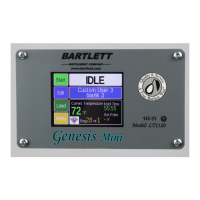13
227°F/hr). If you want to add another segment to go from 750°F to 1000°F in 4 hours, the same
procedure is used. Take the end temperature minus the starting temperature (1000 – 750 = 250) and
divide this number by the number of hours to reach 1000°F (250°F ÷ 4 hrs = 63°F/hr).
Custom Ceramics Program
Writing your own ceramics program combines the versatility of the Custom program and the
heat-work calculation of a ceramics firing. It is a great way to get custom heating and cooling rates and
still have the controller do the heat-work calculation to get the correct cone bend regardless of firing
rate. The steps to write your own cone fire are the same as entering a Custom program except when
programming the top temperatures, press the “CONE” button, scroll until the desired cone number is
displayed, and press “SAVE”. The selected cone’s top temperature will be displayed under Temp for that
segment. The cone temperature can be entered into any segment so you can also have cool down
segments in the program.
Start A Firing
Press “Start” to open the Start Firing Screen. There are 3 options as to how you’d like to begin
the firing. To start the kiln immediately, press “1-Start Now”, enter the start code (Default = 1), and
press “Start”. To program the kiln to start in a set amount of time press “2-Start Later”, enter the start
code, press “Start”, enter a delay start time of up to 4 hours, and press “SAVE”. CAUTION: Make sure
the kiln area will stay clear and safe throughout the delay time and firing time. To arm the controller
for a remote start via the KISS program, press “3-Remote Start”, enter the start code, and press “Start”.
The controller will now read “REMOTE” at the top. This means the area around the kiln is clear, it’s
loaded, and it can be fired at any time from the KISS program.
Operation of the Controller During A Firing
The Genesis controller eliminates much of the “babysitting” that is required with a manual kiln.
To ensure the most consistent results from one firing to the next, you should understand how the
controller operates and monitor the firing to ensure proper operation. The following diagram and flow
chart show the basic components of a kiln’s control system.

